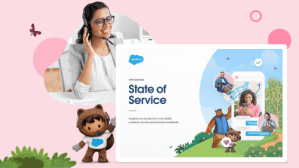From only follow-up calls and reaching out to support teams, customer experience today has come to mean all the interactions the customer has with the brand in the digital and physical world – before, during and after they purchase a product or service. Service is an integral part of this journey, and has the potential to take away or add to this experience.
The Fifth Edition of the Salesforce State of Service report delves into how customer service is changing in a digital-first world and how service organisations are responding to this. The report, which surveyed 8000+ respondents from 36 countries (of which 300+ are from India), explored how businesses are building smarter customer service operations while keeping costs under control.
Customer service is reflecting changing customer expectations
Customers expect more than just prompt service. The report highlights that customers expect businesses to:
- Understand their unique needs
- Provide seamless, intelligent resolutions
- Increase digital engagement
- Deliver empathetic customer service at the customer’s doorstep
Across the globe and in India as well, service-focused companies perceive good customer service as a revenue centre. To maximise brand impact, they are focusing on building their customer service strategy around social media and a digital-first landscape.
Here are some key ways in which organisations in India are looking to enhance their customer service to deliver great customer experience:
1. Extend service across digital channels to engage customers on their preferred channel
While traditional channels of customer engagement – such as email (83%), phone (82%), and SMS (82%) – persist, there is also growing engagement on newer digital channels such as social media, apps and Web 3.0 platforms. Customers expect that businesses will offer an integrated and seamless service experience across channels, whether they reach out to commerce, marketing, after-sales, or support.

By leveraging the right tools, businesses can offer personalised customer service across digital channels, unlock greater productivity, and reduce costs and hours per resource.
For instance, businesses are now offering highly interactive self-service tools, such as product or service selectors, chatbots and pricing calculators, across channels. This allows them to divert employees from routine, admin tasks to more important customer-facing services needed to ensure reliability and repeat purchases.
2. Unify customer information to provide a 360-degree view to customer service teams
The State of Service report found that almost 69% of companies use a single CRM solution across departments to break down silos and improve service efficacy. Customers are keener than ever to interact with businesses high on empathy. However, even though most customers expect businesses to understand their unique needs and expectations, more than half of them feel they are seen just as numbers, according to Salesforce State of Connected Customer Report.
Creating a deep connection requires businesses to empower all staff with an integrated, unified view of the customer journey, including past purchases and service requests, feedback, and preferences and buying behaviour. This can help create empathetic brand engagement, by allowing service reps to personalise the interactions that they have.
Unified CRM solutions help collate customer data from different touchpoints, using it to create a comprehensive customer profile that helps teams deliver tailored engagement. By investing in an integrated and complete CRM solution like Salesforce Customer 360, businesses can help their employees identify and understand unique customer needs and deliver highly personalised experiences at speed.
3. Use technology to automate and streamline processes
63% of respondents said they have adopted process/workflow automation.
Given the economic environment, businesses are turning to technology to deliver better customer service with lesser resource allocation. Automation can help businesses to increase the speed of resolution and improve the quality of customer relationships, without burning out front-line agents. Automated workflows and processes help reduce errors, enable greater organisation-wide collaboration and help free up agents’ time for high-impact engagement.
4. Use AI to get deeper understanding of customer behaviour
The State of Service report revealed that almost 57% of surveyed service organisations use AI for understanding the customer behaviour.
AI technology, such as Salesforce’s Einstein, can be used to create chatbots and virtual assistants, enabling self-service platforms for customers looking for more control over their experience, and also for smart data collection and analysis.
Customer communication creates huge volumes of data that can give important insights into customer behaviour, preferences, and other factors. AI can help collect and organise such crucial data for service agents and help predict next steps as well, leading to greater customer lifetime value and RoI.
5. Extend customer service to customers’ doorstep
Field service is emerging as a preferred customer service channel for high-touch interactions. It helps businesses deliver the personalised connection that customers expect, resulting in greater brand equity and selling opportunities.

Delivering excellent field service requires deploying Field Service Management solutions as well as equipping field personnel with adequate training. When leveraged properly, field service solutions can become a business facilitator, enabling greater productivity, increasing upselling and cross-selling opportunities, and driving customer satisfaction.
Customer centricity is at the core of exceptional customer experience. By delivering efficient customer service, you can show your customers that you care and set the foundation for building trust and long lasting relationships.

























